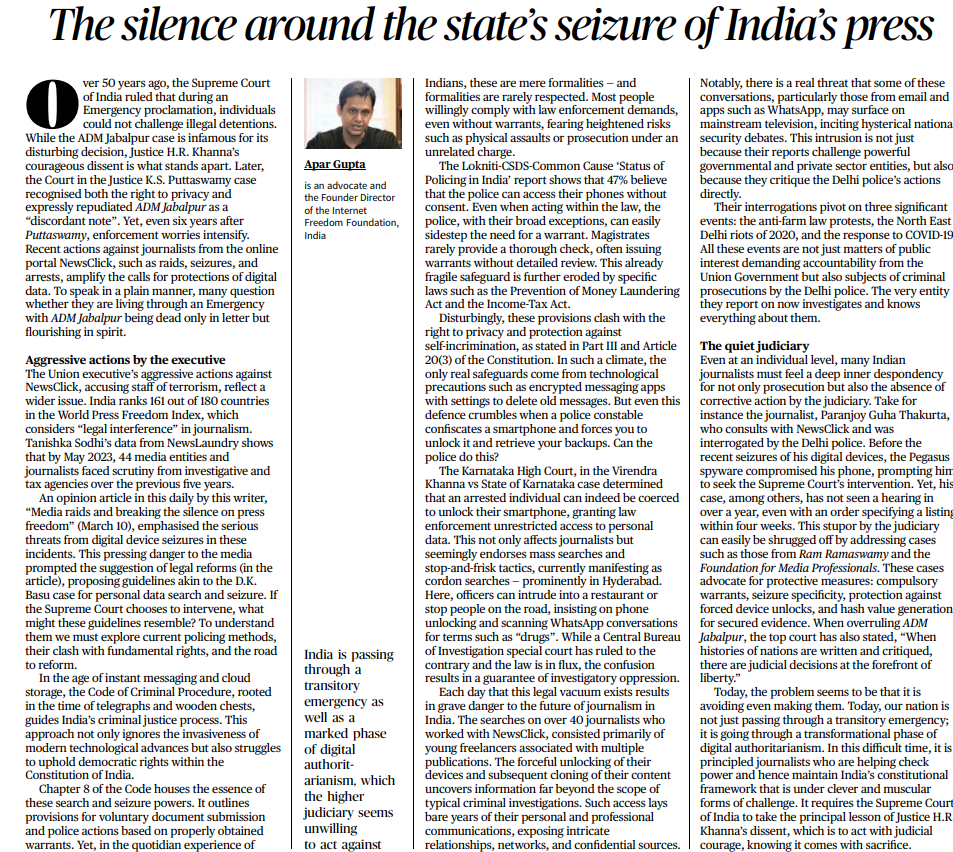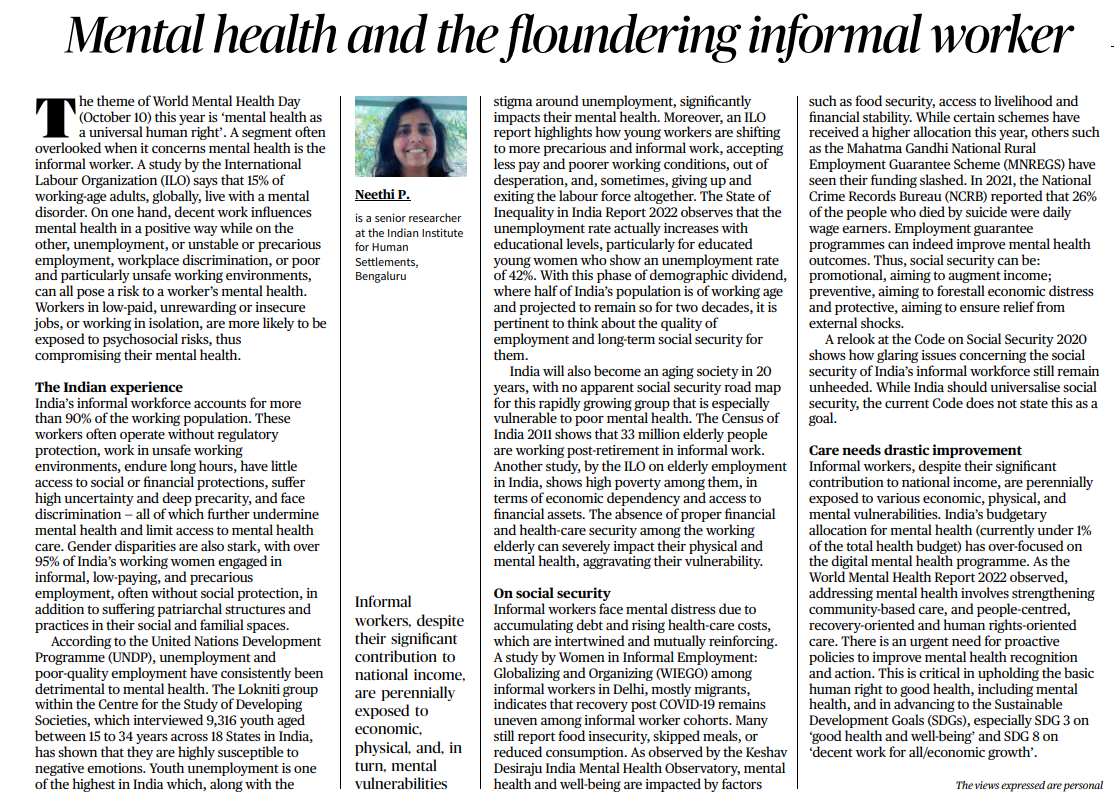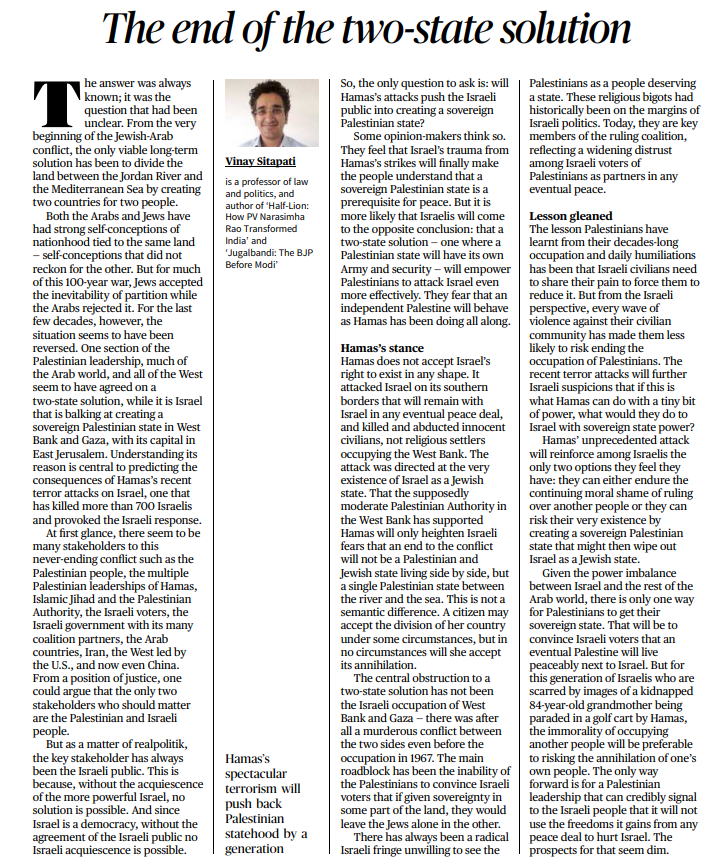Challenges to Press Freedom and Digital Privacy in India: A Critical Analysis
Introduction:
- The Supreme Court of India’s ruling from over 50 years ago in the ADM Jabalpur case, which denied individuals the right to challenge illegal detentions during an Emergency, remains a dark chapter in Indian legal history.
- Justice H.R. Khanna’s courageous dissent in the case stands as a beacon of hope. Although the subsequent Justice K.S. Puttaswamy case recognized the right to privacy and rejected ADM Jabalpur, concerns about its enforcement persist.
- Recent actions against journalists from NewsClick, including raids, seizures, and arrests, have reignited calls for digital data protection. This raises questions about whether India is witnessing an Emergency in spirit if not in letter.
Aggressive Executive Actions:
- The aggressive actions of the Union executive against NewsClick, accusing its staff of terrorism, reflect a broader issue of press freedom in India.
- The country ranks 161 out of 180 in the World Press Freedom Index, highlighting concerns about “legal interference” in journalism. Investigations and tax scrutiny targeting 44 media entities and journalists in the last five years underscore these challenges.
- The need for legal reforms, similar to the guidelines proposed in the D.K. Basu case for personal data search and seizure, has gained urgency.
Outdated Legal Framework:
- India’s criminal justice process, as outlined in the Code of Criminal Procedure, is outdated, designed for a time before modern technological advances.
- Chapter 8 of the Code addresses search and seizure powers, emphasizing the importance of obtaining proper warrants.
- However, in practice, these formalities are often disregarded, with individuals willingly complying with law enforcement demands, even without warrants, due to fear of repercussions.
Erosion of Privacy and Constitutional Rights:
- Surveys indicate that a significant portion of the population believes that the police can access their phones without consent.
- Broad exceptions in the law allow the police to sidestep the need for a warrant, and magistrates often issue warrants without thorough review.
- This erosion of safeguards clashes with the right to privacy and protection against self-incrimination as enshrined in the Constitution of India.
- The use of specific laws such as the Prevention of Money Laundering Act and the Income-Tax Act further exacerbates the situation.
Coercion to Unlock Devices:
- The Virendra Khanna vs. State of Karnataka case has set a precedent that allows law enforcement to coerce individuals into unlocking their smartphones, providing unrestricted access to personal data.
- This practice not only affects journalists but also opens the door to mass searches and stop-and-frisk tactics, raising concerns about investigative oppression.
Threats to Journalism:
- The recent searches and seizures targeting journalists associated with NewsClick reveal the dangers posed by the indiscriminate access to personal and professional communications.
- This intrusion not only jeopardizes journalistic integrity but also exposes individuals to potential national security debates, further stifling press freedom.
The Quiet Judiciary:
- The judiciary’s slow response to cases involving press freedom and digital privacy, such as the Paranjoy Guha Thakurta case, underscores the need for corrective action. Advocates for protective measures, including compulsory warrants, seizure specificity, protection against forced device unlocks, and secure evidence handling, seek to address these issues.
- The Supreme Court must heed the lessons of history and act with judicial courage to safeguard India’s constitutional framework.
Conclusion:
India is facing a transformative phase of digital authoritarianism that threatens press freedom and individual privacy.
Principled journalists play a crucial role in upholding the country’s constitutional framework.
It is imperative that the Supreme Court of India takes inspiration from Justice H.R. Khanna’s dissent and acts with judicial courage to protect these fundamental rights, even in the face of sacrifice.
World Mental Health Day - 'Mental Health as a Universal Human Right'
Introduction
World Mental Health Day on October 10 centers around the theme of ‘mental health as a universal human right.’ While this is a crucial topic, it often overlooks the plight of informal workers, who constitute a significant portion of the global workforce and face unique challenges in maintaining their mental well-being.
Global Perspective
- The International Labour Organization (ILO) reports that 15% of working-age adults worldwide live with a mental disorder. Decent work can positively influence mental health, but unemployment, unstable employment, workplace discrimination, and unsafe working conditions can harm mental health.
- Workers in low-paying, insecure jobs or isolated work environments are more exposed to psychosocial risks, jeopardizing their mental health.
The Indian Experience
- In India, over 90% of the workforce is informal, lacking regulatory protection, working in unsafe conditions, enduring long hours, and facing discrimination.
- Gender disparities are stark, with more than 95% of working women engaged in low-paying and precarious employment without social protection.
- Youth unemployment is a significant issue in India, leading to negative emotions and affecting mental health. Young workers often accept precarious jobs due to desperation.
Future Challenges in India
- India’s aging population lacks a clear social security roadmap, making them vulnerable to poor mental health.
- Elderly individuals working in informal jobs face economic dependency and lack access to financial assets, worsening their mental and physical health.
- With a large working-age population in India, addressing employment quality and long-term social security is vital.
Social Security
- Informal workers in India suffer mental distress due to debt accumulation and rising healthcare costs.
- The COVID-19 pandemic exacerbated disparities among informal workers, with many experiencing food insecurity and reduced consumption.
- Employment guarantee programs like the Mahatma Gandhi National Rural Employment Guarantee Scheme (MNREGS) can improve mental health outcomes by offering financial stability.
Code on Social Security 2020
– The Code on Social Security 2020 in India fails to address critical issues concerning the social security of informal workers and lacks a goal of universalizing social security.
Improving Mental Health Care
– Despite their significant contribution to the national income, informal workers face persistent vulnerabilities.
– India’s budget allocation for mental health is below 1% of the total health budget, with a disproportionate focus on digital mental health programs.
– A more proactive approach is needed to strengthen community-based care and ensure people-centered, recovery-oriented, and human rights-oriented mental health care.
Conclusion
The theme of ‘mental health as a universal human right’ for World Mental Health Day highlights the critical need to address the mental well-being of informal workers, especially in countries like India with a large informal workforce. Proactive policies, improved social security, and accessible mental health care are essential steps to uphold the fundamental right to good mental health and work towards Sustainable Development Goals.
The end of Two-State solution
Introduction
The Jewish-Arab conflict in the region has persisted for a century, with the central issue being the division of land between the Jordan River and the Mediterranean Sea into two separate states for two distinct peoples.
While both Jews and Arabs have strong national identities tied to this land, their self-conceptions have often clashed, making the pursuit of a peaceful solution challenging.
Historical Shift in Perspectives
- Over time, the willingness to accept a two-state solution has shifted between the parties involved.
- Initially, Jews were more amenable to partition, while Arabs rejected it.
- However, recent years have seen a reversal, with Palestinian leadership, the Arab world, and the West largely supporting a two-state solution, while Israel hesitates to create a sovereign Palestinian state.
Key Stakeholders
- Various stakeholders are involved in this enduring conflict, including the Palestinian people, multiple Palestinian leadership factions (Hamas, Islamic Jihad, Palestinian Authority), Israeli voters, the Israeli government and its coalition partners, Arab nations, Iran, the West (particularly the U.S.), and even China.
- However, from a practical standpoint, the Israeli public holds a pivotal role as their acquiescence is essential for any resolution.
Role of the Israeli Public
- Israel’s status as a democracy means that without the agreement of its people, no solution can be realized.
- Thus, the crucial question is whether recent attacks by Hamas will push the Israeli public toward supporting the creation of a sovereign Palestinian state.
Impact of Hamas’s Attacks
- While some opinion-makers believe that Hamas’s attacks will make Israelis realize the necessity of a Palestinian state for peace, others fear the opposite outcome.
- They argue that an independent Palestine could have its own military and security forces, potentially enabling more effective attacks on Israel.
- This raises concerns that an independent Palestine could behave similarly to Hamas, which denies Israel’s right to exist and has targeted Israeli civilians.
Obstruction to a Two-State Solution
- The central obstacle to a two-state solution has not solely been the Israeli occupation of the West Bank and Gaza, as hostilities existed even before the 1967 occupation.
- Instead, the main challenge has been convincing Israeli voters that granting sovereignty to Palestinians would result in peaceful coexistence.
Radical Israeli Fringe
- Historically, a radical fringe in Israeli politics rejected the idea of Palestinians deserving a state.
- However, these fringe elements are now part of the ruling coalition, reflecting growing distrust among Israeli voters regarding Palestinians as viable peace partners.
Lessons Learned
- Palestinians have learned that inflicting pain on Israeli civilians can compel them to consider ending the occupation.
- Conversely, Israelis view such violence as a reason to maintain the status quo.
- Recent attacks by Hamas have reinforced Israeli suspicions about the consequences of a sovereign Palestinian state.
Path Forward
- The power imbalance between Israel and the Arab world means that Palestinians must convince Israeli voters that they will live peacefully alongside Israel.
- However, this task is challenging, as images of violence perpetrated by Hamas have scarred this generation of Israelis.
- The only way forward is for Palestinian leadership to credibly signal to Israelis that they will not use newfound freedoms to harm Israel, but prospects for this appear dim.




